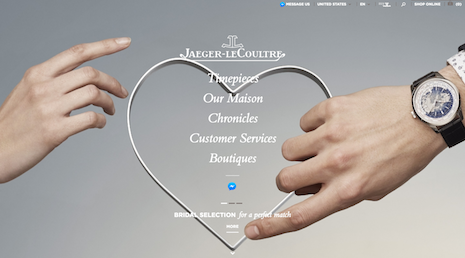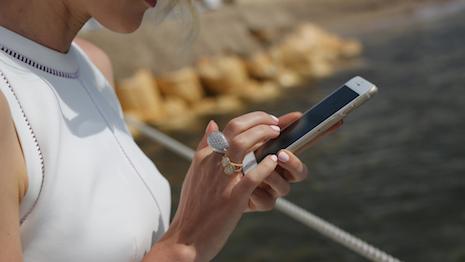 Elle Fanning in Tiffany's Legendary Style campaign
Elle Fanning in Tiffany's Legendary Style campaign
A lack of price transparency in jewelers’ online flagships could be costing them business by sending interested buyers to grey market retailers, according to a new report from L2.
The luxury jewelry and watch industry has been facing declining sales over the past couple of years, but while bricks-and-mortar revenues are down, digital purchases are up. Providing a direct path to purchase from online channels, something 44 percent of jewelers fail to do, may help brands capture more sales themselves rather than inadvertently sending shoppers to unauthorized outlets.
L2’s “Digital IQ Index: Watches & Jewelry 2017” looks at the digital competency of 70 brands across digital, ecommerce mobile and social.
Grey area
For the second year in a row, Tiffany & Co. and Cartier top L2’s rankings, with both receiving genius scores.
Tiffany won the top spot for its omnichannel fulfillment options, strong Instagram presence and its mobile presence, which includes an application dedicated to finding the right engagement ring.
Second place Cartier also got recognition for its ecommerce site, with the brand also boasting the best-performing YouTube channel.
 Cartier's Etourdissant collection
Others to make the top 10 include Swarovksi, David Yurman, Tag Heuer, Montblanc, Longines and Van Cleef & Arpels, all of whom were considered gifted.
One thing that all of the gifted brands share is a direct-operated ecommerce platform.
While 53 percent of brands offer direct-to-consumer selling online, a mere 26 percent of index brands offer ecommerce for all of their pieces.
Cartier's Etourdissant collection
Others to make the top 10 include Swarovksi, David Yurman, Tag Heuer, Montblanc, Longines and Van Cleef & Arpels, all of whom were considered gifted.
One thing that all of the gifted brands share is a direct-operated ecommerce platform.
While 53 percent of brands offer direct-to-consumer selling online, a mere 26 percent of index brands offer ecommerce for all of their pieces.
 Jaeger-LeCoultre added ecommerce to its Web site
Some brands have chosen to align with partners for their first foray into ecommerce, with Vacheron Constantin working with Hodinkee and IWC Schaffhausen pairing with Net-A-Porter and Mr Porter.
L2 notes a general lack of investment in online flagships this past year. In 2015, 42 percent of the index brands updated their Web sites, while only 14 percent did so in 2016.
Even if consumers are buying in-store, having a platform that provides information and inspiration as well as a path to purchase is key in keeping sales within a brand’s official channels. Close to a third of index brands keep pricing details off their Web sites, and many rely on emails or phone calls to guide consumers to conversion at a boutique.
Despite this frequent lack of a path to purchase, 98 percent of the brands studied have some form of guided selling on their Web site, whether videos, user-generated content or other editorial features.
L2 pointed to the untapped potential of email marketing for jewelers. Three quarters of online shoppers and 25 percent of in-store clients subscribe to newsletters, but jewelers are only reaching them with 0.7 emails per week.
Jaeger-LeCoultre added ecommerce to its Web site
Some brands have chosen to align with partners for their first foray into ecommerce, with Vacheron Constantin working with Hodinkee and IWC Schaffhausen pairing with Net-A-Porter and Mr Porter.
L2 notes a general lack of investment in online flagships this past year. In 2015, 42 percent of the index brands updated their Web sites, while only 14 percent did so in 2016.
Even if consumers are buying in-store, having a platform that provides information and inspiration as well as a path to purchase is key in keeping sales within a brand’s official channels. Close to a third of index brands keep pricing details off their Web sites, and many rely on emails or phone calls to guide consumers to conversion at a boutique.
Despite this frequent lack of a path to purchase, 98 percent of the brands studied have some form of guided selling on their Web site, whether videos, user-generated content or other editorial features.
L2 pointed to the untapped potential of email marketing for jewelers. Three quarters of online shoppers and 25 percent of in-store clients subscribe to newsletters, but jewelers are only reaching them with 0.7 emails per week.
 Photo courtesy of jeweler Boucheron
There have been very slight investments on brand mobile sites, a channel becoming increasingly important as customer journeys increasingly start on smaller screens. Additionally, only 44 percent of index brands have a mobile app, with a number dedicating their apps to a single function rather than a selling platform, such as Chaumet's travel app (see story).
Social selling
Video is an important medium for jewelers, with 78 percent of social media interactions coming from YouTube.
On other social channels, the top brands dominate the engagement. Tiffany receives an average of 32,000 interactions per Instagram post, eight times the index average.
Close to all of index brands are now on Instagram, but Snapchat adoption remains below a third. Not surprisingly, brands are more apt to post Instagram stories than Snapchat stories.
When looking at what content performs, L2 found that unlike other categories, celebrities are not needed to boost engagement for jewelers’ posts.
Social media can also be used to lead consumers further down the purchase funnel.
For instance, U.S. jeweler Harry Winston is making a connection between its Instagram content and its physical points of sale through a shoppable feed.
Photo courtesy of jeweler Boucheron
There have been very slight investments on brand mobile sites, a channel becoming increasingly important as customer journeys increasingly start on smaller screens. Additionally, only 44 percent of index brands have a mobile app, with a number dedicating their apps to a single function rather than a selling platform, such as Chaumet's travel app (see story).
Social selling
Video is an important medium for jewelers, with 78 percent of social media interactions coming from YouTube.
On other social channels, the top brands dominate the engagement. Tiffany receives an average of 32,000 interactions per Instagram post, eight times the index average.
Close to all of index brands are now on Instagram, but Snapchat adoption remains below a third. Not surprisingly, brands are more apt to post Instagram stories than Snapchat stories.
When looking at what content performs, L2 found that unlike other categories, celebrities are not needed to boost engagement for jewelers’ posts.
Social media can also be used to lead consumers further down the purchase funnel.
For instance, U.S. jeweler Harry Winston is making a connection between its Instagram content and its physical points of sale through a shoppable feed.
 Harry Wintson's Like2Buy platform
The brand, which does not offer ecommerce, is leveraging Curalate’s Like2Buy platform to drive in-store appointments and product exploration instead of online purchases. Brands’ Instagram audiences tend to be the most engaged, making this initiative a means to connect the brand’s digital followers with its frontline staff (see story).
Also, Swiss watchmaker Jaeger-LeCoultre is stepping away from typical luxury watch manufacturer strategy with an innovative experience that introduces a chatbot to Facebook followers as an out-of-store associate.
Interested customers on Facebook can now interact with Jaeger-LeCoultre to find the perfect watch for them. The chatbot recommends suitable watches based on users’ responses to questions, a strategy that greatly differs from traditional watch brands that usually rely on their name to carry them (see story).
Harry Wintson's Like2Buy platform
The brand, which does not offer ecommerce, is leveraging Curalate’s Like2Buy platform to drive in-store appointments and product exploration instead of online purchases. Brands’ Instagram audiences tend to be the most engaged, making this initiative a means to connect the brand’s digital followers with its frontline staff (see story).
Also, Swiss watchmaker Jaeger-LeCoultre is stepping away from typical luxury watch manufacturer strategy with an innovative experience that introduces a chatbot to Facebook followers as an out-of-store associate.
Interested customers on Facebook can now interact with Jaeger-LeCoultre to find the perfect watch for them. The chatbot recommends suitable watches based on users’ responses to questions, a strategy that greatly differs from traditional watch brands that usually rely on their name to carry them (see story).
